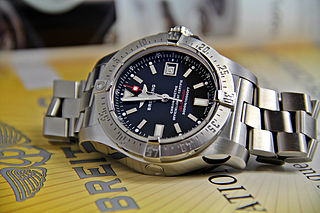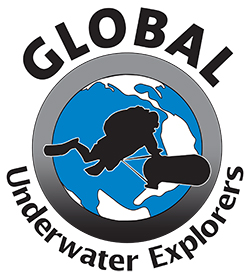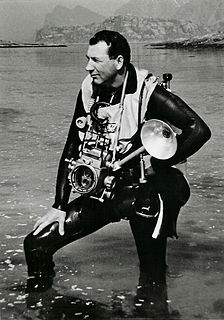Related Research Articles

Trimix is a breathing gas consisting of oxygen, helium and nitrogen and is used in deep commercial diving, during the deep phase of dives carried out using technical diving techniques, and in advanced recreational diving.

Technical diving is scuba diving that exceeds the agency-specified limits of recreational diving for non-professional purposes. Technical diving may expose the diver to hazards beyond those normally associated with recreational diving, and to a greater risk of serious injury or death. The risk may be reduced by appropriate skills, knowledge and experience, and by using suitable equipment and procedures. The skills may be developed through appropriate specialised training and experience. The equipment often involves breathing gases other than air or standard nitrox mixtures, and multiple gas sources.

Deep diving is underwater diving to a depth beyond the norm accepted by the associated community. In some cases this is a prescribed limit established by an authority, while in others it is associated with a level of certification or training, and it may vary depending on whether the diving is recreational, technical or commercial. Nitrogen narcosis becomes a hazard below 30 metres (98 ft) and hypoxic breathing gas is required below 60 metres (200 ft) to lessen the risk of oxygen toxicity.

Wreck diving is recreational diving where the wreckage of ships, aircraft and other artificial structures are explored. Although most wreck dive sites are at shipwrecks, there is an increasing trend to scuttle retired ships to create artificial reef sites. Diving to crashed aircraft can also be considered wreck diving. The recreation of wreck diving makes no distinction as to how the vessel ended up on the bottom.

The International Association of Nitrox and Technical Divers (IANTD) is a scuba diving organization concerned with certification and training in recreational diving, technical diving, cave diving, wreck diving, rebreather diving and diver leadership. Formed in 1985, it pioneered the introduction of Enriched Air Nitrox diving to the recreational diving community. The European Association of Technical Divers (EATD) became part of IANTD in 1993.
Diving physics are the aspects of physics which directly affect the underwater diver and which explain the effects that divers and their equipment are subject to underwater which differ from the normal human experience out of water.

Recreational diving or sport diving is diving for the purpose of leisure and enjoyment, usually when using scuba equipment. The term "recreational diving" may also be used in contradistinction to "technical diving", a more demanding aspect of recreational diving which requires greater levels of training, experience and equipment to compensate for the more hazardous conditions associated with the disciplines. Breath-hold diving for recreation also fits into the broader scope of the term, but this article covers the commonly used meaning of scuba diving for recreational purposes, where the diver is not constrained from making a direct near-vertical ascent to the surface at any point during the dive, and risk is considered low.
Keith Jessop was a British salvage diver and successful marine treasure hunter.

A diving watch, also commonly referred to as a diver's or dive watch, is a watch designed for underwater diving that features, as a minimum, a water resistance greater than 1.0 MPa (10 atm), the equivalent of 100 m (330 ft). The typical diver's watch will have a water resistance of around 200 to 300 m, though modern technology allows the creation of diving watches that can go much deeper. A true contemporary diver's watch is in accordance with the ISO 6425 standard, which defines test standards and features for watches suitable for diving with underwater breathing apparatus in depths of 100 m (330 ft) or more. Watches conforming to ISO 6425 are marked with the word DIVER'S to distinguish ISO 6425 conformant diving watches from watches that might not be suitable for actual scuba diving.
John Bennett (1959–2004) was a British scuba diver who set a world record by becoming the first person to deep dive below a depth of 300 m (1,000 ft) on self-contained breathing apparatus on 6 November 2001. Bennett first broke the record in 1999 when he reached 200m accompanied by Chuck Driver, then again in 2000 Benbett set a new record of 254m, before his final record breaking dive to 308m in 2001. Having founded Atlantis Dive in the Philippines in the late 1990s, Bennett and his world record breaking team, including Ron Loos, Mark Cox and Targa Mann went on to establish Tech Dive Academy in Port Douglas, Australia. In the early 2000s, Bennett and Loos made the first dives to the MV Princess of the Orient wreck site in Manila Bay. In 2001, he located the wreck of the Imperial Japanese Navy dreadnought Yamashiro through sound scans, but could not confirm it before his death. Confirmation was not made until 2017.
Gary Gentile is an American author and pioneering technical diver.

Global Underwater Explorers (GUE) is a scuba diving organization that provides education within recreational, technical, and cave diving. It is a nonprofit membership organization based in High Springs, Florida, United States.

Simon Mitchell is a New Zealand physician specialising in occupational medicine, hyperbaric medicine and anesthesiology. Trained in medicine, Mitchell was awarded a PhD for his work on neuroprotection from embolic brain injury. Mitchell has also published more than 45 research and review papers in the medical literature. Mitchell is an author and avid technical diver. He also wrote two chapters of the latest edition of Bennett and Elliott's Physiology and Medicine of Diving, is the co-author of the diving textbook Deeper Into Diving with John Lippmann and co-authored the chapter on Diving and Hyperbaric Medicine in Harrison's Principles of Internal Medicine with Michael Bennett.
Leigh Bishop is an explorer and deep sea diver known for his deep shipwreck exploration and still underwater photography.

There are several categories of decompression equipment used to help divers decompress, which is the process required to allow divers to return to the surface safely after spending time underwater at higher pressures.
Captain Guybon Chesney Castell Damant was a British royal navy officer known for his scientific research on preventing decompression illness with John Scott Haldane, his leadership over a team of divers that salvaged 44 tons of gold bullion from the wreck of HMS Laurentic between 1917 and 1924, and the covert work he and his divers performed by entering into sunken U-boats during World War I and recovering code books, ciphers, and other materials for the Naval Intelligence Division of the Royal Navy.

The history of scuba diving is closely linked with the history of scuba equipment. By the turn of the twentieth century, two basic architectures for underwater breathing apparatus had been pioneered; open-circuit surface supplied equipment where the diver's exhaled gas is vented directly into the water, and closed-circuit breathing apparatus where the diver's carbon dioxide is filtered from the exhaled breathing gas, which is then recirculated, and more gas added to replenish the oxygen content. Closed circuit equipment was more easily adapted to scuba in the absence of reliable, portable, and economical high pressure gas storage vessels. By the mid-twentieth century, high pressure cylinders were available and two systems for scuba had emerged: open-circuit scuba where the diver's exhaled breath is vented directly into the water, and closed-circuit scuba where the carbon dioxide is removed from the diver's exhaled breath which has oxygen added and is recirculated. Oxygen rebreathers are severely depth limited due to oxygen toxicity risk, which increases with depth, and the available systems for mixed gas rebreathers were fairly bulky and designed for use with diving helmets. The first commercially practical scuba rebreather was designed and built by the diving engineer Henry Fleuss in 1878, while working for Siebe Gorman in London. His self contained breathing apparatus consisted of a rubber mask connected to a breathing bag, with an estimated 50–60% oxygen supplied from a copper tank and carbon dioxide scrubbed by passing it through a bundle of rope yarn soaked in a solution of caustic potash. During the 1930s and all through World War II, the British, Italians and Germans developed and extensively used oxygen rebreathers to equip the first frogmen. In the U.S. Major Christian J. Lambertsen invented a free-swimming oxygen rebreather. In 1952 he patented a modification of his apparatus, this time named SCUBA, an acronym for "self-contained underwater breathing apparatus," which became the generic English word for autonomous breathing equipment for diving, and later for the activity using the equipment. After World War II, military frogmen continued to use rebreathers since they do not make bubbles which would give away the presence of the divers. The high percentage of oxygen used by these early rebreather systems limited the depth at which they could be used due to the risk of convulsions caused by acute oxygen toxicity.

The following index is provided as an overview of and topical guide to underwater divers:

Underwater divers are people who take part in underwater diving activities – Underwater diving is practiced as part of an occupation, or for recreation, where the practitioner submerges below the surface of the water or other liquid for a period which may range between seconds to order of a day at a time, either exposed to the ambient pressure or isolated by a pressure resistant suit, to interact with the underwater environment for pleasure, competitive sport, or as a means to reach a work site for profit or in the pursuit of knowledge, and may use no equipment at all, or a wide range of equipment which may include breathing apparatus, environmental protective clothing, aids to vision, communication, propulsion, maneuverability, buoyancy and safety equipment, and tools for the task at hand.
References
- ↑ Ellyatt, M. "Solo 313m Depth Record" . Retrieved 2008-07-23.
- ↑ "A journey to 308 Meters". Archived from the original on 2008-07-20. Retrieved 2008-07-23.
- ↑ "Scuba Records - deep records". Archived from the original on 2009-03-12. Retrieved 2010-04-29.
- ↑ Smith, Alithea (8 August 2006). "Mark Ellyatt's Ocean Gladiator". Archived from the original on 24 July 2011. Retrieved 20 June 2011.
- ↑ Diving-News.com. "HMS Victoria's Secret - Lebanon". Archived from the original on 6 October 2008. Retrieved 2008-07-23.
- ↑ Nicholas Blanford. "Divers discover British ship wreck after 111 years". The Daily Star Newspaper - Lebanon.
- ↑ Ellyatt, M. "OCEAN GLADIATOR: Battles beneath the ocean" . Retrieved 2008-07-23.